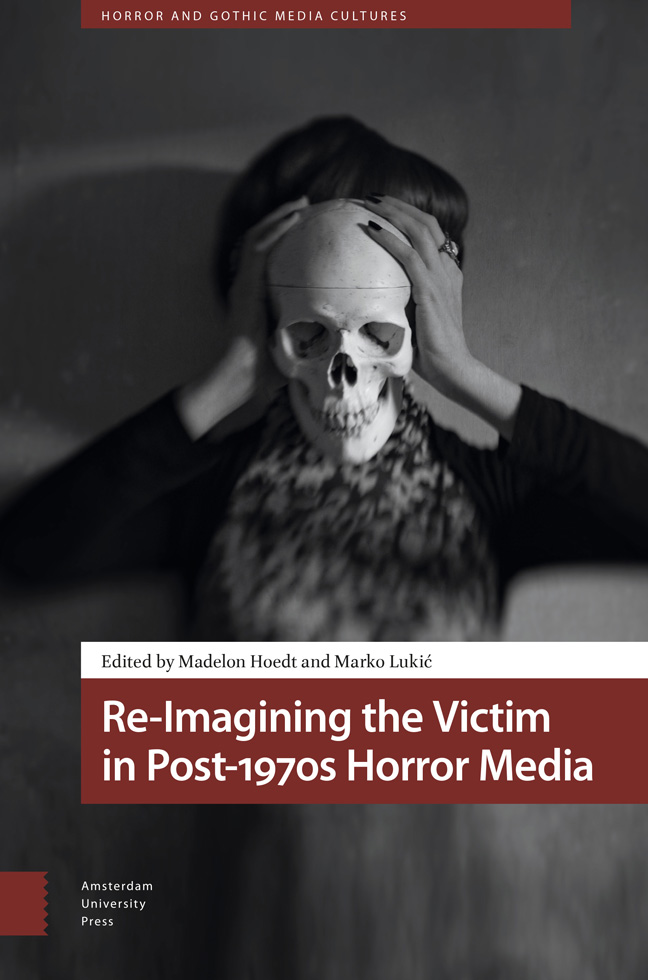Book contents
- Frontmatter
- Contents
- Introduction: Theorising the Victim
- 1 Opening the Gate: Reconfiguring the Child Victim in Stranger Things
- 2 Black Death: Black Victims in 1980s Teen Slashers
- 3 Beyond Binaries: The Position of the Transgender Victim in Horror Narratives
- 4 Through the Looking-Glass: The Gothic Victim in Jordan Peele’s Us
- 5 Postmortem Victimhood: Necrovalue in Phantasm and Dead and Buried
- 6 The Sad Killer: Perpetuating Spaces, Trauma and Violencewithin the Slasher Genre
- 7 “If this is the last thing you see… that means I died”: A Taxonomy of Camera-Operating Victims in Found Footage Horror Films
- 8 Victimhood and Rhetorical Dialectics within Clive Barker’s Faustian Fiction
- 9 Pain Index, Plain Suffering and Blood Measure: A Victimology of Driving Safety Films, 1955–1975
- 10 Biolithic Horror: Stone Victim/Victimisers in Resident Evil Village
- 11 The Potential Victim: Horror Role-Playing Games and the Cruelty of Things
- Bibliography
- Filmography
- Index
3 - Beyond Binaries: The Position of the Transgender Victim in Horror Narratives
Published online by Cambridge University Press: 26 March 2024
- Frontmatter
- Contents
- Introduction: Theorising the Victim
- 1 Opening the Gate: Reconfiguring the Child Victim in Stranger Things
- 2 Black Death: Black Victims in 1980s Teen Slashers
- 3 Beyond Binaries: The Position of the Transgender Victim in Horror Narratives
- 4 Through the Looking-Glass: The Gothic Victim in Jordan Peele’s Us
- 5 Postmortem Victimhood: Necrovalue in Phantasm and Dead and Buried
- 6 The Sad Killer: Perpetuating Spaces, Trauma and Violencewithin the Slasher Genre
- 7 “If this is the last thing you see… that means I died”: A Taxonomy of Camera-Operating Victims in Found Footage Horror Films
- 8 Victimhood and Rhetorical Dialectics within Clive Barker’s Faustian Fiction
- 9 Pain Index, Plain Suffering and Blood Measure: A Victimology of Driving Safety Films, 1955–1975
- 10 Biolithic Horror: Stone Victim/Victimisers in Resident Evil Village
- 11 The Potential Victim: Horror Role-Playing Games and the Cruelty of Things
- Bibliography
- Filmography
- Index
Summary
Abstract
Academic discussions of the transgender presence in horror film have focused mostly on the problematic association between transness and monstrosity, neglecting readings of transgender in proximity to victimhood. This chapter considers how, in the portrayal of transgender characters in horror film, the dissolution of gender boundaries often coincides with the conflation of victimhood and villainy. Relying on the concepts of the Final Girl and the monstrous-feminine, the chapter discusses the changing position of the transgender killer in three films: A Reflection of Fear by William A. Fraker (1972), Hiltzik’s Sleepaway Camp (1983) and Ari Aster’s Hereditary (2018). The analysis explores the transgender characters’ movements from victims to monsters while investigating the extent to which these characters complicate the binary approach.
Keywords: gender, A Reflection of Fear, Sleepaway Camp, Hereditary, monstrosity, film
In November 1957, residents of the small town of Plainfield, Wisconsin, opened their morning newspapers to learn that their lonesome neighbour Ed Gein was not the mild-mannered handyman that he seemed. The police investigation into Gein’s home soon revealed that this ordinary, quiet American man was in fact a gruesome serial killer who dismembered women, preserved their bodily remains and fashioned them into clothing items and household furniture. The revelation that Gein simply enjoyed wearing women’s flesh as clothes, rather than using women’s flesh for sexual gratification, had a significant impact on the popular mythology of his crimes surrounding his alleged “transsexuality.” In the wake of the investigation of the Butcher of Plainfield’s crimes, the psychotic, murderous cross-dresser has become a well-known trope in American horror cinema, popularised most notably in Hitchcock’s Psycho (1960) and Demme’s The Silence of the Lambs (1991). By framing experiences of gender-bending in these narratives of violence, such films, of which there are more, have contributed to a negative codification of transgender people as murderous, monstrous and mentally ill.
Both Psycho and The Silence of the Lambs, however, seem to be less concerned with depicting a transgender biography and more with the assertion of the character’s mental instability by portraying the act of cross-dressing as a mere performance ritual within the greater act of killing.
- Type
- Chapter
- Information
- Re-Imagining the Victim in Post-1970s Horror Media , pp. 61 - 78Publisher: Amsterdam University PressPrint publication year: 2024

